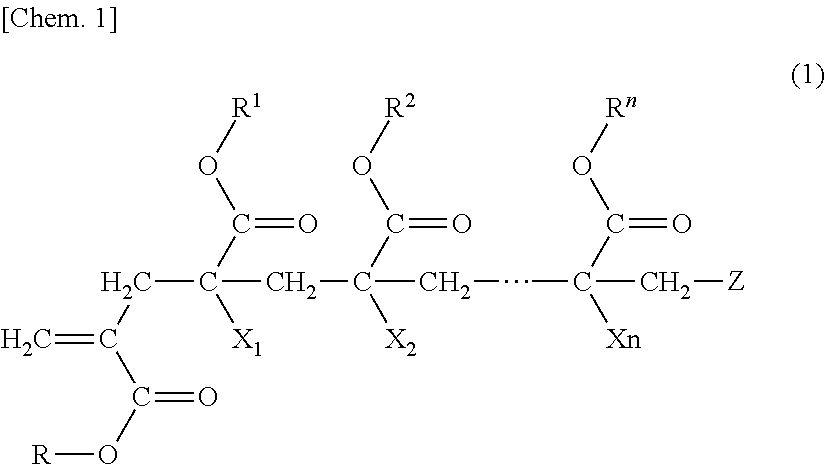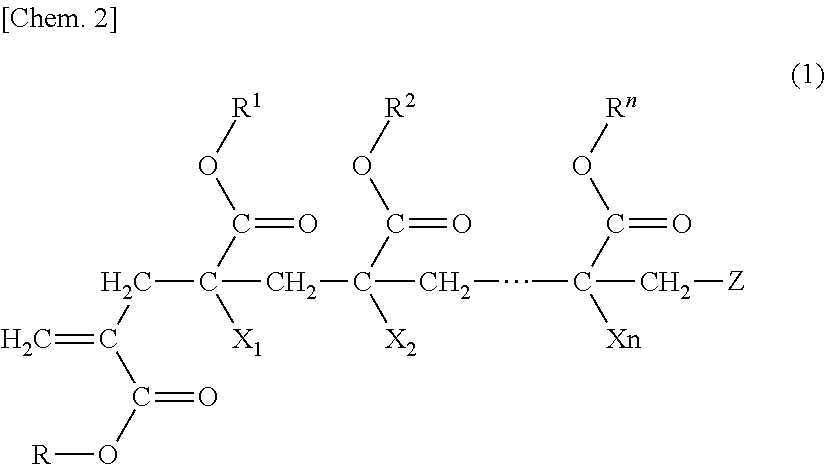Polymer, production method for same, and molded article
a technology of polymer and production method, applied in the field of polymer, can solve the problems that the monomer used in the monomer cannot achieve sufficient pliability in the acrylic resin molded article, and cannot meet the diverse conditions that are required for a material, etc., to achieve the effect of high pliability, low haze value, and exceptional pliability
- Summary
- Abstract
- Description
- Claims
- Application Information
AI Technical Summary
Benefits of technology
Problems solved by technology
Method used
Image
Examples
production example 1
Synthesis of Dispersion Agent (1)
[0240]Into a reaction vessel (volume: 1200 L) equipped with a stirrer, a condenser, and a thermometer, 61.6 parts of 17% aqueous solution of potassium hydroxide, 19.1 parts of ACRYESTER M (trade name, methyl methacrylate, manufactured by MITSUBISHI RAYON CO., LTD.), and 19.3 parts of deionized water were added. Subsequently, the solution in a reaction apparatus was stirred at room temperature, the exothermic peak was determined, and stirring was further continued for 4 hours. Thereafter, the reaction solution in the reaction apparatus was cooled to room temperature to obtain an aqueous solution of potassium methacrylate.
[0241]Subsequently, into a reaction vessel (volume: 1,050 L) equipped with a stirrer, a condenser, and a thermometer, 900 parts of deionized water, 60 parts of ACRYESTER SEM-Na (trade name, sodium 2-sulfoethyl methacrylate, manufactured by MITSUBISHI RAYON CO., LTD.), 10 parts of the above aqueous solution of potassium methacrylate, a...
production example 2
Synthesis of Co Complex (1) (Cobalt Chain Transfer Agent)
[0242]Into a synthesis apparatus equipped with a stirring device, 2.00 g (8.03 mmol) of cobalt (II) acetate tetrahydrate (manufactured by Wako Pure Chemical Industries, Ltd., Wako Special grade), 3.86 g (16.1 mmol) of diphenyl glyoxime (manufactured by Tokyo Chemical Industry Co., Ltd., EP grade), and 100 ml of diethyl ether from which oxygen has been removed in advance by nitrogen bubbling were added and stirred for 2 hours at room temperature.
[0243]Subsequently, 20 ml of diethyl ether boron trifluoride complex (manufactured by Tokyo Chemical Industry Co., Ltd., EP grade) was added and further stirred for 6 hours. The resultant was filtered, and the solid was washed with diethyl ether and dried for 12 hours at 20° C. and 100 Mpa or less to obtain 5.02 g (7.93 mmol, yield: 99% by mass) of a Co complex (1) as a brown solid.
production example 3
Synthesis of Macromonomer (a-1)
[0244]Into a polymerization apparatus equipped with a stirrer, a condenser, and a thermometer, 145 parts of deionized water, 0.1 part of sodium sulfate (Na2SO4), and 0.26 part of the dispersion agent (1) (solid content: 10% by mass) produced in Production Example 1 were added followed by stirring to obtain a homogenous aqueous solution.
[0245]Next, 95 parts of ACRYESTER M, 5 parts of methyl acrylate (MA) (manufactured by Mitsubishi Chemical Corporation), 0.0016 part of the Co complex (1) produced in Production Example 2, and 0.1 part of PEROCTA O (trade name, 1,1,3,3-tetramethylbutylperoxy2-ethylhexanoate, manufactured by NOF CORPORATION) as a polymerization initiator were added to obtain an aqueous dispersion. Subsequently, the inside of the polymerization apparatus was sufficiently purged with nitrogen and the temperature of the aqueous dispersion was raised to 80° C. The aqueous dispersion was maintained for 4 hours, and then the temperature of the a...
PUM
| Property | Measurement | Unit |
|---|---|---|
| Tg | aaaaa | aaaaa |
| molecular weight distribution | aaaaa | aaaaa |
| temperature | aaaaa | aaaaa |
Abstract
Description
Claims
Application Information
 Login to View More
Login to View More - R&D
- Intellectual Property
- Life Sciences
- Materials
- Tech Scout
- Unparalleled Data Quality
- Higher Quality Content
- 60% Fewer Hallucinations
Browse by: Latest US Patents, China's latest patents, Technical Efficacy Thesaurus, Application Domain, Technology Topic, Popular Technical Reports.
© 2025 PatSnap. All rights reserved.Legal|Privacy policy|Modern Slavery Act Transparency Statement|Sitemap|About US| Contact US: help@patsnap.com



